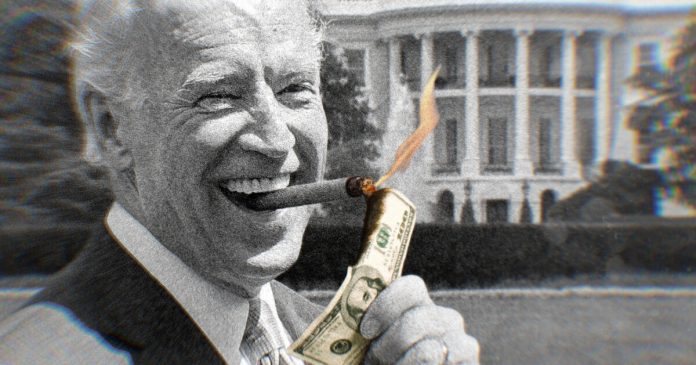How much will President Joe Biden’s huge expansion of social programs cost?
Congress has authorized spending of up to $3.5 trillion over a ten-year period. But Biden is urging Democrats to fully pay the bill by increasing taxes on corporations and the rich, negotiating the price for prescription drugs, and dialing up other sources such as the increased IRS funding.
The idea is that the entire package should be able to pay for itself.
Democrats want to stop a deficit-financed spending spree by defending a bill that is not yet complete. They are becoming frustrated at the attention being paid to the $3.5 trillion in spending while arguing that far too little is being done to balance the books. Biden said Friday that he prefers the price tag to be described as “zero”.
“We pay for everything we spend,” Biden said at the White House. “It’s going to be zero. Zero.”
The revenue side of this equation is difficult and has emerged as a major challenge for Democratic bargainers, who are trying to build one of the most significant legislative efforts in a generation. The success or failure of these negotiations could determine whether Biden’s entire agenda is passed and can withstand any political attacks.
Republicans are not waiting for details, even though they have joined the opposition. They have shifted their attention to the $3.5 trillion spending limit set by Democrats and are now praising that amount as fiscally reckless, misguided and big government at its worst.
“The radical left is pushing in all their chips — they want to use this terrible but temporary pandemic as a Trojan horse for permanent socialism,” Senate Republican leader Mitch McConnell of Kentucky said Thursday. “Trillions upon trillions more in government spending when families are already facing inflation.”
The lack of consensus on which programs and how long to fund is a major problem for Democratic leaders. House Speaker Nancy Pelosi (D-Calif.) and Senate Majority Leader Chuck Schumer (D-N.Y.) acknowledge that the price will likely fall and have a list of revenue-raisers to help pay for it. However, it is impossible to make final decisions without knowing which initiatives will be included.
“This is not about price tag,” Pelosi said Thursday. “This is about what’s in the bill.”
Biden and officials from the administration stressed that the plan is more about fairness than dollars and cents. They plan to tax the rich and corporations in order to provide paid family leave and child credits for those who are striving for the middle class. At the same time, they will adopt economic and environmental policies that improve the U.S.’s ability to compete with China. The haggling over the final spending target is distracting from the policy goals they want to achieve.
Washington Rep. Pramila Jayapal is a leading negotiator of House progressives and said that journalists should not portray the measure as costing trillions when the proposed tax increases would cover it.
“I just believe that this is going to be a zero-dollar-bill — that’s the No. 1 priority,” she stated.
President of the Center on Budget and Policy Priorities in Washington Sharron Parrott warned Democrats not to focus too much on the $3.5 trillion figure.
“The debate so far has been overly focused on a single number: the $3.5 trillion in gross new investments over the next ten years — including both spending increases and tax cuts — that may be included in the package,” Parrott wrote in an August blog post. “True fiscal stewardship requires a focus on the net cost of the package and, even more fundamentally, a focus on the merits of the investment and offset proposals themselves.”
Biden’s real goal is to achieve two different goals, which can easily conflict. Biden wants to bring the middle class back to the epicenter for economic growth. However, he doesn’t want to increase the national debt nor tax those earning less than $400,000 per year.
Complicating matters further is the fact that many of his spending plans are tax cuts for middle and poor people. This means that he raises taxes for one group to pay less for another.
The Congressional Budget Office is the final arbiter on how the legislation will impact the federal balance sheet and must be dealt with by Democrats.
The Democrats’ expanded child credit and dependent care credits, enacted earlier this year, are counted as costs in a CBO score. Biden wants to extend these programs as part of the budget, which he is now arguing amounts to one of the largest middle-class tax cuts in U.S. history.
“It’s reducing taxes, not increasing taxes,” Biden said Friday.
It is not clear whether Biden’s claim that there will be no cost under the 10-year CBO outlook to evaluate the economic impact of legislation. Biden’s budget officials had earlier this year calculated that his agenda would lead to a nearly $1.4 trillion increase in national debt over the next decade.
Biden on Friday described the multi-tiered talks with legislators as at a “stalemate.” More meetings are expected in coming days.
The evenly divided Senate has key Democratic senators, such as Joe Manchin from West Virginia and Kyrsten Sinema from Arizona, who have reservations about total spending. Democratic moderates are trying to gain an advantage over their liberal counterparts. Biden asks for patience as he races against time to get the numbers correct so the votes can follow.
“This is a process,” he said. “But it’s just gonna take some time.”








